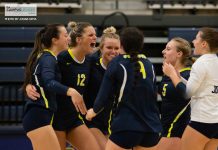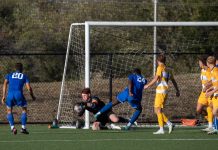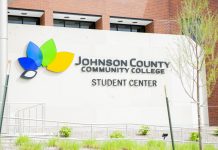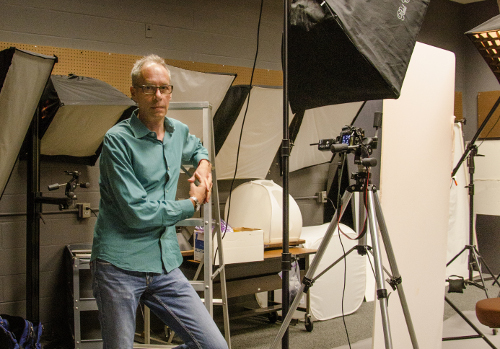By David Hurtado
Photography professor shares his lifetime of experience
The office is small by most standards, but by no means lacks the personal touches of an occupant. A curious glance around ATB 143 reveals bits-and-bobs of photography equipment and other personal effects, each tucked into its own spot.
This is the office of Philip Heying, one of the adjunct professors in the photography department at the college. Heying, a well known figure in the art community, has taught at the college since the fall 2010 semester. His interest in photography first sparked at an early age, when he would sneak off with the family camera to take pictures, using up all of the Polaroid.
“There was something really magical that a machine could reproduce what looked like reality,” Heying said. “The machine itself was beautiful and the little pieces of reality that came out of it were fascinating. That happened when I was 5-years-old.”
Prior to coming to the college, Heying worked as a freelance photographer after graduating from the University of Kansas in 1985 with a BFA in Painting. While studying art at KU, Heying received the Sterling Scholarship, an undergraduate research award. Not long after graduation, he moved to Paris and worked there for 12 years. In 1997, Heying packed his bags and returned to the states, taking up residence in Brooklyn until 2008.
“Moving to Paris was really something because I had to learn a whole new language and a whole new culture,” he said. “Not just the French language and the French culture, but I went from the suburban rural environment of Kansas City and Northeast Kansas to one of the cultural capitals of the world in a densely urban environment. I had to get used to being really close to a lot of people and just a different kind of culture and cultural awareness of the arts. It was a little bit of a baptism by fire, if you will. I loved it.”
Before Heying departed for the City of Light, he became close friends with acclaimed novelist and painter, William Burroughs. Heying met Burroughs during his time as a student at KU, and through Burroughs’s circle of friends, including Albert Hoffman and Allen Ginsburg, gained artistic guidance and insight. Gradually, Heying began to shift his focus from painting to photography exclusively. They remained friends until Burroughs’s death in 1997.
“He was like no one else,” he said. “[Burroughs] was old enough he could have been my grandfather and yet he was a visionary and boldly inhibited person in terms of his own beliefs and personal practices. It was always a bit of an adventure to hang around with him because he was actually in fact, a dangerous person in a certain way. Not that he was malicious in any sense, but he liked to explore a part of reality that is truly dangerous and was curious about what was there.”
Bruce Hartman, curator of photography, Nerman Museum, said what sets Heying apart from other photographers are his life experiences and upbringing in Kansas. He said Heying’s work reflects someone who has familiarity with the Kansas landscape in the sense that he isn’t someone who’s just passing through the rolling hills and flat plains.
“Certainly, some of his history and life experiences; the fact that he grew up in Kansas and has familiarity with the region,” Hartman said. “When he’s taking photographs, he’s actually experienced the landscape; he came home essentially and began several bodies of work. That’s a different stance than someone who happens to come to an area for a limited period of time and doesn’t fully understand it, in perhaps the way someone who grew up here might. His roots are here, and I think you can see that reflected in the work that he’s executing.”
Adam Long, adjunct professor, Photography, said it’s a “positive experience” working with Heying. He said since the two are both photographers, they often bounce ideas off one another and have a great camaraderie.
“I would say that he’s direct, but at the same time very approachable,” Long said. “It comes off in a way that, his comments are pointed, but they’re done in such a way that there’s a lot of love in them. His personality, when I think about it, springs from his directness. He’s got a nice sense of dry humor, too.”
Hartman said Heying’s greatest strength as a photographer lies in his ability to take the most mundane subjects and make them into something beautiful and compelling.
“I think his ability to take subjects that many people might consider banal and make them really engaging and quite beautiful is his greatest strength,” he said. “It’s always a gift when someone can take subject matter many consider to be mundane and make it something that’s captivating and compelling too. And, that’s apart from the William Burroughs photographs, as those have a life of their own, so to speak. Burroughs was such a legendary and colorful figure that it’s almost impossible to disassociate his personality/legend from those images. That’s a body of work that I think is unto itself – specific to Lawrence, Kansas and a particular time.”
Contact David Hurtado, features editor, at dhurtado@jccc.edu.






















